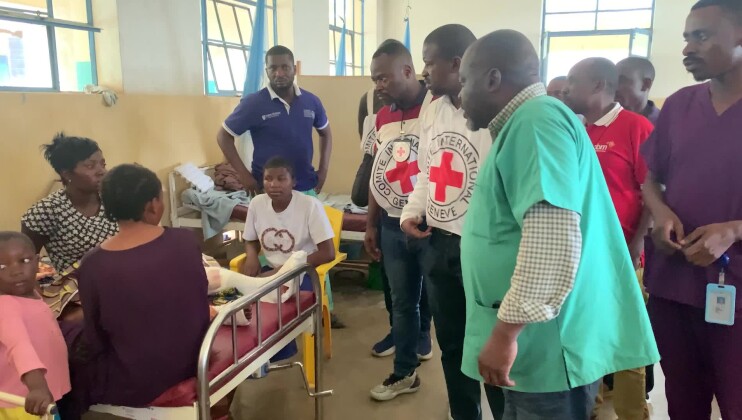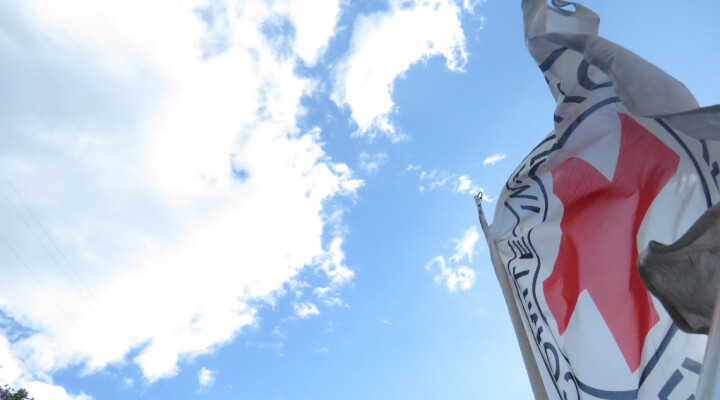A Beacon of Hope: Treaty banning nuclear weapons enters into force
The first treaty to ban nuclear weapons is about to come into force (22 January 2021).
At a time when the world is struggling with issues that go beyond borders - pandemics and climate risks - this new treaty is a victory for humanity.
“It is the first legally binding instrument that specifically prohibits the use, the development, the production and stockpiling and the testing of weapons that cause horrific humanitarian consequences,” states ICRC’s Director of International Law and Policy, Helen Durham. “It’s a powerful signal that nuclear weapons are not only morally unacceptable but illegal under international humanitarian law, the laws of war.”
The International Committee of the Red Cross first called for a nuclear weapons ban in 1945 after caring for victims of the atomic bombings of Hiroshima and Nagasaki. In the hospitals, the doctors and nurses witnessed first-hand the unspeakable suffering and destruction unleashed by these weapons.
Sumiteru Taniguchi was 16 years old when the bomb hit Nagasaki. He was on his bicycle delivering post. “I was thrown to the ground and my back burnt instantaneously,” recalls Taniguchi. “I felt the ground shaking and thought I was going to die. As things calmed down, I realized the skin on my left arm, from the shoulder to the tip of my fingers, was trailing down like a rag. I felt no pain. I put my hand to my back and found my shirt was gone and something black and slimy was all over my hand. My bicycle was completely twisted like candy.”
Taniguchi spent three years and seven months in hospital, teetering on the edge of death. All his life, he’s been in pain and afraid his two children would suffer from inheritable radiation effects.
Today, there are over 13,000 nuclear bombs in the world. Many much more powerful than the ones used in the 1940s. Moreover, thousands of these bombs are on high alert, ready to be launched in an instant and vulnerable to human error and cyber attacks.
So far 51 countries have ratified the Treaty on the Prohibition of Nuclear Weapons (TPNW) and will begin the next steps of disclosing whether they possess nuclear weapons and providing a plan for their elimination. These states have also committed to helping those who’ve been victims of testing and cleaning up contaminated areas.
ICRC’s Head of Delegation for Southern Africa, Mamadou Sow states: “African countries were among the first to commit to the treaty prohibiting the use of nuclear weapons. What we need know is that more countries will ratify and implement the treaty. The treaty alone will not make nuclear weapons go away overnight but it does send a very strong signal to all that: the use, the threat of use and the possession of these weapons are absolutely unacceptable in our world today.”
For further information, please contact:
Juliette Ebele, ICRC Geneva, +41 79 298 94 81, jebele@icrc.org
PHOTOS – captions embedded in the photos
SHOTLIST
Location: Geneva, Switzerland
Camera: mobile phone footage - horizontal
Filming date: 13.1.2021
Copyright: ICRC access all
On Screen Credit: ICRC or logo
SOUNDBITE: Helen Durham, International Law and Policy Director, ICRC (In English)
0:00 “At a time when the world is struggling with global issues, issues that go beyond borders, such as pandemics and climate risks, this new treaty is surely a victory for humanity. Not only does the nuclear weapons treaty provide us with a pathway to the elimination of such weapons, it is a concrete step towards the implementation of existing obligations under nuclear disarmament, such as those found in the non proliferation treaty. Furthermore, it provides the obligation and accountability of states to support those who’ve been victims of testing and to clean up contaminated areas.”
0:43 Archive footage of the nuclear bombings of Hiroshima and Nagasaki in 1945
SOUNDBITE: Helen Durham, International Law and Policy Director, ICRC (In English)
1:55 “We are witnessing an historic moment: the entry into force of the treaty in the prohibition of nuclear weapons. It is the first legally binding instrument that specifically prohibits the use, the development, the production and stockpiling and the testing of weapons that cause horrific humanitarian consequences. It’s a powerful signal that nuclear weapons are not only morally unacceptable but illegal under international humanitarian law, the laws of war.”
Location: Nagasaki, Japan
Sound: Japanese
Date: July 23 2015
2:27 Various of Nagasaki Peace Memorial Park
2:57 Various of exterior of Red Cross hospital in Nagasaki
3:12 Sumiteru Taniguchi showing his wounds * distressing images and says
“My rib bones dug inside of my body and surface of skin was decomposed. My heart and lungs were damaged due to compression by bones.”
SOUNDBITE Sumiteru Taniguchi, atomic bomb survivor (in Japanese):
4:22 “I was thrown to the ground with the bicycle at the speed of 200-300 meter per second and my back was burnt by blast and radiation in a blink of eyes. I felt the ground shaking for a while and thought I was going to die. But I assured myself that I couldn’t die there.
4:47 “As things calmed down, I realized that my skin of my left arm, from the shoulder to the tip of my fingers, was trailing down like a rag. Having felt no pain, I put my hand to my back and found my shirts were gone and something black and slimy was all over my hand. My bicycle was completely twisted like a candy.
5:04 “I was not bleeding and felt no pain. I dragged myself to the nearby tunnel then wandered around to seek a shelter.”
5:21 “I saw many people burned instantly and it was hard to recognize if it was a man or woman. I wanted to help them but seemed like I lost all of my energy and strength.”
5:59 Various of Sumiteru Taniguchi being examined by Dr Matsuoka
SOUNDBITE Dr Masao Tomonaga, honorary director of the Japanese Red Cross Nagasaki Atomic Bomb Hospital (in Japanese)
6:28 Survivors have been suffering from the radiation effect for their entire lifetime. I mean most of current patients are the people who were under 10 years old at that time. They were children when they experienced the atomic bomb. They still develop leukemia and cancers or die from cardiac infarction. For those people, the fear of late effect have been dominant since they were 10 years old. They never had a moment of relief from the fear of being diagnosed with leukaemia or cancers. Nobody could tell them that “your suffering is over”.
7:00 Dr Masao Tomonaga explaining his research slides
SOUNDBITE: Helen Durham, International Law and Policy Director, ICRC (In English)
7:15 Like all new Iegal instruments, the entry into force of this new treaty on the prohibition of nuclear weapons, it’s the start not the end of a long journey. We have a long way to go but we need to mark and celebrate that we have a treaty. After over 75 years, there is a legal instrument. However for it to have impact, a number of things need to be done. The first is we need to make sure that it is widely signed up to and ratified, that the political leaders have the vision and the courage to sign on the right side of history. But we also need to make sure that the obligations contained in the treaty are known and understood and faithfully implemented. If all these steps are done we move closer to a world that doesn’t live under the threat of nuclear war.
SOUNDBITE Mamadou Sow ICRC’s Head of Delegation for Southern Africa (in English)
8:09 “South Africa was the first country to have voluntarily disbanded its entire nuclear weapons programmes. African countries were among the first to commit to the treaty prohibiting the use of nuclear weapons. What we need know is that more countries will ratify and implement the said treaty. Make no mistake, the treaty alone will not make nuclear weapons go away overnight but it does send a very strong signal to all that the use, the threat of use, the possession of these weapons are absolutely unacceptable in our world today.”
END 8:49



